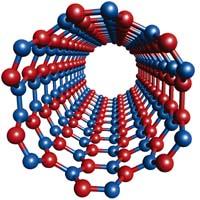Angel Rubio Secades: "Nanotubes will be one of the ingredients of the technological revolution"

Two aspects must be differentiated. On the one hand, we explain and analyze the characteristics of carbon nanotubes from different fields, that is, nanotubes from different technological applications. On the other hand, models of combination of nanotubes with other materials are presented. This combination results in new nanostructured materials for mechanical, optical and communications applications, among others. All this in collaboration with different experimental and nanotube study groups.
On the other hand, twelve years ago we said that in addition to carbon nanotubes, they would also be boron nitride nanotubes. We realized that there was a general law of formation of nanotubes and then expanded the group of nanotubes to most inorganic laminar structure compounds. In principle, every laminar structure system can form nanotubes. Currently, for example, we are investigating nanotubes of superconducting materials at high temperatures.
However, the prize has been, above all, for predicting the nanotubes of boron nitride. These nanotubes can be applied and combined in other systems.
They are tubular structures with an approximate diameter of a nanometer. The best known are carbon ones, but they are also nanotubes of other materials such as boron nitride.
Carbon nanotubes are basic carbon structures such as diamond, graphite, or fulerene. They are rounded graphite layers in cylindrical shape.

By rounding a layer of graphite a cylinder is formed. This is the carbon nanotube. That is, rounded graphite. Depending on the twisting of graphite layers, the properties of the nanotube vary, being conductors or semiconductors.
I put a simple example: the hair is a cylinder of a micron of diameter. A nanotube is somewhat similar, but about a thousand times smaller diameter.
Carbon nanotubes were synthesized in the early 1990s and are researched by different groups of researchers. In fact, on the one hand, its synthesis is simpler, on the other, the abundance of carbon in nature and, on the other, its lightness. Regarding this last feature, we could say the same for boron nitride.
Carbon nanotubes can be conductors or semiconductors. Boron nitride is insulating, as boron nitride is a very good, very light and resistant insulator. The latter also have the advantage of being able to emit light in the ultraviolet and the same device would store more information.
There are as many inorganic nanotubes, including molybdenum sulfide, which are generally used as lubricants.

Considering technological applications, nanotubes are hard, flexible and lightweight materials. They can be conductors, semiconductors or insulators. In addition, they have a high thermal conductivity. That is, if in a device there are nanotubes, they are able to extract heat. Therefore, they are able, for example, to keep computers at an appropriate temperature. The problem with many devices is that they get too hot. On the other hand, due to the basic characteristics of nanotubes, several investigations can be carried out that have not been possible until now.
But, undoubtedly, the electronic characteristics are the ones that arouse the most attention at present. It can be said that the future is in those characteristics. For this, transistors, diodes, connectors, etc. must belong to this scale. In addition, the semiconductor tube itself can also act as a transistor. It is therefore about studying integration with the current driver, silicon. This molecular electronics will bring faster, more efficient, lighter and lower consumption devices.
Yes, it is. In everyday life, nanotubes and, in general, nanotechnology are used to reinforce various building materials, emit electrons on flat screens, etc. Of course, on a very small scale.
It also has several applications in research. Medical research, for example, is undergoing trials to treat a type of skin cancer with functional nanotubes. The nanotube is itself toxic. Therefore, if it is placed next to any cell, it dies. Therefore, they must be functioned so that they can kill the corresponding cell. However, all these biomedical advances must be prudent.
Looking ahead, we want to improve information storage systems, data transmission speed and data processing. Nanotubes will be one of the components of this technological revolution. Whether they are going to be basic components or not, I cannot assure you. I have great doubts.

However, they are perfect and therefore suitable materials for basic research. They help us investigate a number of features that we could not otherwise know. Once fully controlled, one of the researchers' objectives is to find a simple way to produce carbon nanotubes in large quantities. In fact, they currently work in the laboratory with a single nanotube, two, three... Millions of them want to work. There is the challenge. This challenge has two aspects: on the one hand, we must invent the path of synthesis, that is, how to produce it (nowadays almost manually), and on the other, know how to handle all that information.
It seems good to me to create debate, but never on the basis of the ideas we have. I think you have to leave some freedom to scientists. I don't think scientists will move blindly without knowing if these materials are toxic.
I set an example. Marie Curie discovered X-rays. This radioactive material was responsible for the murder of the well-known scientist. Prolonged exposure to radioactivity. What is clear is that without awareness of toxicity he advanced in numerous studies. If he had known it, perhaps he would not have gone through his head.
What I mean is that there is always a period of adaptation since something is found or thought to move forward. What needs to be done after a discovery is to analyze its advantages and disadvantages. And that takes time. I don't think it's right to say everything related to nano is dangerous, or the other way around, of course. Let scientists propose new things, discover new systems, study new features and functions... They will then be analyzed and their application will be determined to medicine, renewable energy or materials with excellent characteristics that we can use in our daily lives. Or if you see that it is a material to be discarded, discard it. It is about acting with common sense.
Buletina
Bidali zure helbide elektronikoa eta jaso asteroko buletina zure sarrera-ontzian











